Class 11-science H C VERMA Solutions Physics Chapter 6 - Friction
Friction Exercise 97
Solution 1
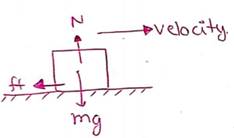
Vertical equilibrium
N=mg
For
horizontal; ![]() ma
ma
![]()
![]()
![]()
![]()
![]()
![]()
Solution 2
Net force = max acceleration
![]()
![]()
![]()
![]()
![]()
Now,
![]()
![]()
![]()
s=50m
Solution 3
Since no driving force is present to move the block. So, frictional force will be zero.
Solution 4
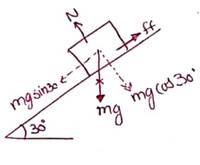
![]()
![]()
![]()
![]()
![]()
![]()
Now,
![]()
![]()
![]()
![]()
From (ii) and (iii)
![]()
![]() 0.11
0.11
Solution 5
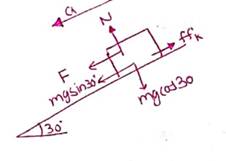
Along inclined plane
![]()
![]()
![]()
![]()
![]()
Now,
![]()
![]()
![]()
s=10 m
Solution 6
a)

Applied force must be greater than net force which is acting downwards to make to move up.
Freq = µN + mgsin30°
N = mgcos30°
M = 2kg , g = 9.8m/s2 , μ = 0.2
On substituting, Freq = 13N.
b)
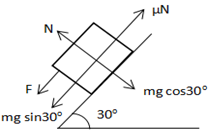
Net force acting down the incline is given by
Fnet = 2gsin30° - μN
= 2×9.8×1/2 - (0.2)[mgcos30°]
= 9.8 - 0.2[2×9.8×√3/2]
= 6.41N
6.41 is the force acting down the inclined plane.
This is enough for the body to slide down. No need to exert extra force. So, force required is zero.
Solution 7
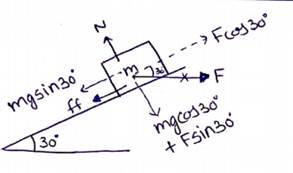
Since the block is just to move up the incline so frictional force will act in downward direction.
Since, block is in equilibrium.
![]() ………(perpendicular to incline)
………(perpendicular to incline)
![]() ……..(along the incline)
……..(along the incline)
Now,
![]()
![]()
![]()
F=17.5 N
Solution 8
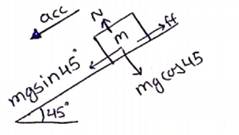
![]() ……(perpendicular to incline)
……(perpendicular to incline)
![]() ….(along the incline)
….(along the incline)
![]()
![]()
![]()
![]()
![]()
Solution 9
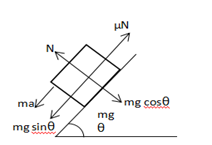
In the first half metre,
u=0m/s, s=0.5m, t=0.5s
v=u+at
v= 0+(0.5×4) = 2m/s
s=ut+1/2at2
0.5=0+12(a)(0.5)2
a=4m/s2
For the next half metre, u=2m/s , a=4m/s2, s=0.5m
0.5 = 2t+(1/2)(4)t2
4t2+4t-1=0
On solving, t=0.2027 sec
Time taken to cover the next half metre is 0.21s.
Solution 10
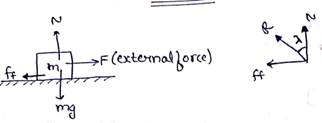
Angle
of friction, ![]()
The
value of friction force depends upon external force applied. If the body does
not move then![]() .
.
When
body is about to move or moves then ff=![]() = μN
= μN
So,
ff<=μN
![]()
![]()
λ≤tan-1(μ)
Solution 11
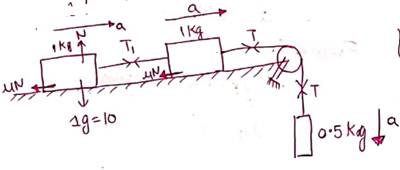
For mass 0.5 Kg
![]()
![]()
for 1 Kg night mass
![]()
![]()
![]()
For 1 Kg left mass
![]()
![]()
Solving (i), (ii) and (iii)
![]()
![]()
![]()
Friction Exercise 98
Solution 12
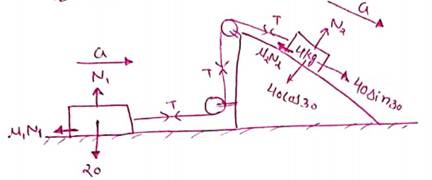
For 2Kg block
![]()
![]()
![]()
![]()
For 4Kg block
![]()
![]()
![]()
![]()
Solution 13
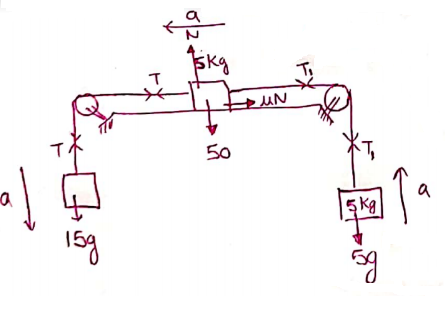
![]()
![]()
![]()
![]()
Adding (i), (ii) and (iii)
15g-g-5g=15a+5a+50
9g=25a
![]()
Now, put in eq.(i)
![]()
![]()
T= 96 N
From eq.(3)
![]()
![]() =68N
=68N
Solution 14
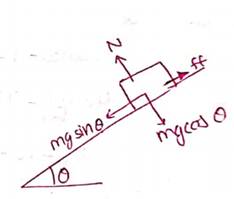
![]()
![]()
![]()
![]()
![]()
Now, by translatory motion equation
![]()
![]()
![]()
![]()
![]()
Squaring
![]()
![]()
![]()
On solving,
![]()
Solution 15
(a) frictional force exerted by ground will be in forward direction.
![]()
![]()
![]()
![]()
![]()
![]()
![]()
![]() sec
sec
(b) While stopping, frictional force will act in opposite direction of motion.
![]()
![]()
![]()
![]()
After covering 50m, the velocity of athelete is
![]()
![]()
![]()
Now,
![]()
![]()
![]()
t=3.33 sec
Solution 16
When driver applies brakes frictional force will be opposite to motion of car.
![]()
![]()
![]()
![]()
s=12.8
We know that,
![]()
![]()
![]()
![]()
![]() Kmph
Kmph
v=36 Kmph
Solution 17
The maximum acceleration for car is given by,
![]()
![]()
![]()
![]()
![]()
t=10 sec
Solution 18
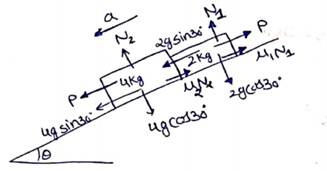
P is the contact force.
![]()
![]() N
N
for 4Kg block
![]()
![]()
![]()
For 2Kg block
![]()
![]()
![]()
On solving (i) and (ii)
![]()
Solution 19
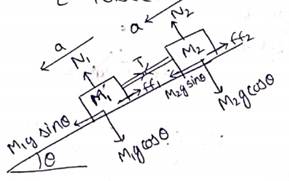
Both blocks are connected by rod.
So, there acceleration must be same.
![]() -----(1)
-----(1)
![]() ------(2)
------(2)
![]() ------(3)
------(3)
![]() -------(4)
-------(4)
Add (1) and (3)
![]()
![]()
![]()
Put in equation (1)
![]()
T=0
Solution 20
Let minimum force required be P at an angle θ.
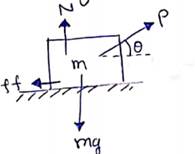
![]() (vertical equilibrium) -(i)
(vertical equilibrium) -(i)
![]() (Body is about to move) -(ii)
(Body is about to move) -(ii)
From (i)
![]()
![]() -(iii)
-(iii)
To minimize P, we have
to maximize ![]()
![]()
![]()
![]()
![]()
Maximum value of ![]()
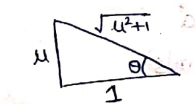
![]()
Put in (3)
So, ![]() at
at ![]()
Solution 21
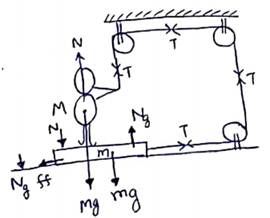
For man
N+T=Mg
For board
![]() (vertical equilibrium)
(vertical equilibrium)
![]() (Horizontal equilibrium)
(Horizontal equilibrium)
![]()
![]()
![]()
It is maximum force exerted by man.
Solution 22
(a)
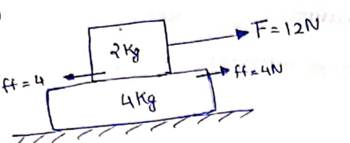
Normal contact for 2Kg = 2g =20 N.
Maximum
friction force between 2Kg and 4Kg= ![]()
![]()
= 4 N
Since F=12 N >ff bond will break
for 2Kg block,
12-4=2a
8=2a
![]()
for 4Kg block,
4-0=4![]()
![]()
(b)

Individual acc.
for 4Kg block,
12-4=4a
![]()
for 2Kg block,
4-0=2![]()
![]()
So,
acceleration of both blocks are![]() .
.
Solution 23
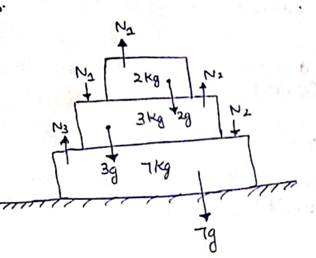
For 2Kg;
![]()
![]()
For 3Kg;
![]()
![]()
For 7Kg;
![]()
![]()
(a)
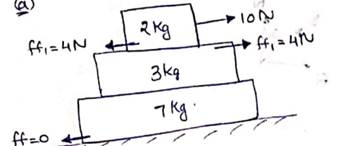
The bond between 2Kg and 3Kg breaks as applied force is more than limiting friction.
Acceleration
of 2Kg block ![]()
![]()
![]()
![]()
Bond between 3Kg and 7Kg will not be broken by 4N force so both will move together.
Acceleration
of 3Kg and 7Kg block ![]()
![]()
![]()
![]()
(b) The bond between 3Kg and 7Kg will not be broken so they will definitely move together.
Now individual acceleration
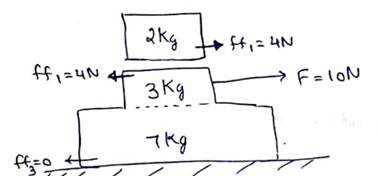
For 2Kg;
![]()
![]()
![]()
For 3Kg and 7Kg;
![]()
![]()
![]()
Acceleration of 2Kg block cannot be greater than 3Kg block.
So, all will move together.
![]()
![]()
![]()
So, ![]()
(c) The bond between 3Kg and 7Kg will
not be broken as applied force (10N) is less than ![]() . So, both
of them moves together.
. So, both
of them moves together.
Now, individual acceleration
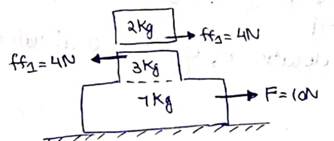
For 2Kg;
![]()
![]()
![]()
For 3Kg and 7Kg;
![]()
![]()
![]()
Acceleration of 2Kg block cannot be greater than 3Kg block.
So, all will move together.
![]()
![]()
![]()
So, ![]() .
.
Solution 24
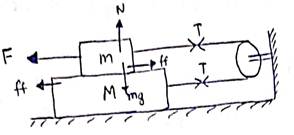
(a)For block m;
N=mg
ff=μN=μmg
F=T + ff (∴ acceleration = μ) -(i)
For block M;
T=ff (∴ acceleration = 0) -(ii)
Solving (i)and(ii),
F=ff + ft
F=2μmg
(b) Now applied force is F=2(2μmg)=4μmg
For block m;
F-T-ff=ma -(i)
For block M;
T-ff=Ma -(ii)
Adding (i)and(ii),
F-2ff =(m + M)a
4μmg-2μmg = (m + M)a
![]() in opposite directions.
in opposite directions.
Solution 25
In elevator, moving down with acceleration a, effective acceleration will be
![]()
So,
replace g by ![]() in above answers.
in above answers.
Solution 26
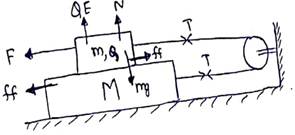
For block m,
QE+N=mg (vertical equilibrium)
N=mg-QE
![]()
F=T + ff (Horizontal equilibrium) -(i)
For block M,
T=ff (Horizontal Equilibrium) -(ii)
Solving (i)and(ii),
F=ff + ft
F=2ff = 2μ(mg-QE)
Friction Exercise 99
Solution 27
When block slips, the limiting friction force acts.
![]()
![]()
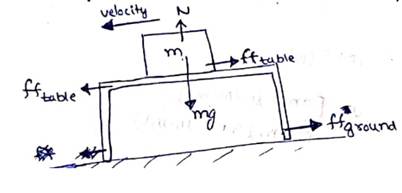
Since the table remains at rest.
![]()
![]()
Solution 28
When a block M, moves with acceleration a towards right block m moves downwards and rightwards with acceleration 2a and a respectively.
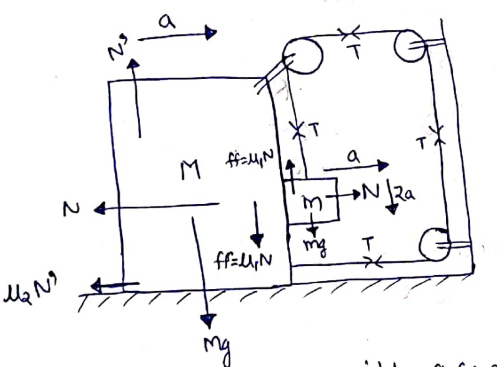
Drawing FBD of M mass
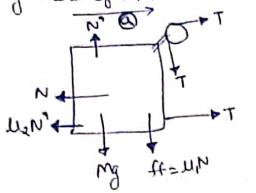
![]() (Vertical) -(i)
(Vertical) -(i)
![]() (Horizontal) -(ii)
(Horizontal) -(ii)
FBD of mass m
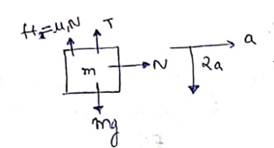
N=ma (Horizontal) -(iii)
![]() (vertical) -(iv)
(vertical) -(iv)
From (iii) and (iv)
![]() -(v)
-(v)
Solving equation (i), (ii), (iii) and (iv)
![]()
Solution 29
Net driving force on the block
![]()
![]()
Limiting friction force=![]()
![]() block will move.
block will move.
For acceleration,
![]()
![]()
![]()
![]()
Direction w.r.t 15N force
![]()
![]() with 15N force.
with 15N force.
Solution 30
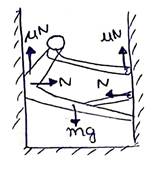
(a) Since the man is at rest horizontally. So, both by both walls on man will be equal and opposite in direction.
(b) In vertical equilibrium condition
![]()
![]()
N=250 N
Solution 31
Initial velocity of both blocks is same. So, ![]()
When m separates from M. ![]()
Let
![]() and
and![]() be the acceleration of the blocks m and M respectively with
respect to ground.
be the acceleration of the blocks m and M respectively with
respect to ground.
Here,
![]() >
>![]() as both blocks separates from each other.
as both blocks separates from each other.
So,
![]()
![]()
![]()
![]() -(i)
-(i)
Now,

FBD of mass m,
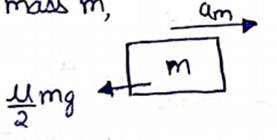
![]()
![]()
![]() -(ii)
-(ii)
FBD of mass M

![]()
![]() -(iii)
-(iii)
Subtract (ii) and (iii)
![]()
Put in e.q. (i)


